Parkinson's Disease Research: Causes, Impact, and UK Services
VerifiedAdded on 2024/06/04
|6
|1699
|423
Report
AI Summary
This research report aims to determine the causes and impact of Parkinson’s disease on individuals' daily lives and to evaluate the health and social services available to them in the UK. It seeks to understand the symptoms, the extent to which the disease affects daily living, and what improvements can be made to existing care. The research methodology involves both primary qualitative and quantitative data collection, alongside secondary research based on literature reviews from scholarly articles, journals, and other ethical sources. The study emphasizes the importance of understanding the patient's perspective, the need for improved diagnosis through biomarkers, and the potential benefits of good-quality social care. Ethical considerations are paramount, ensuring data collection is conducted responsibly and without causing harm to participants.
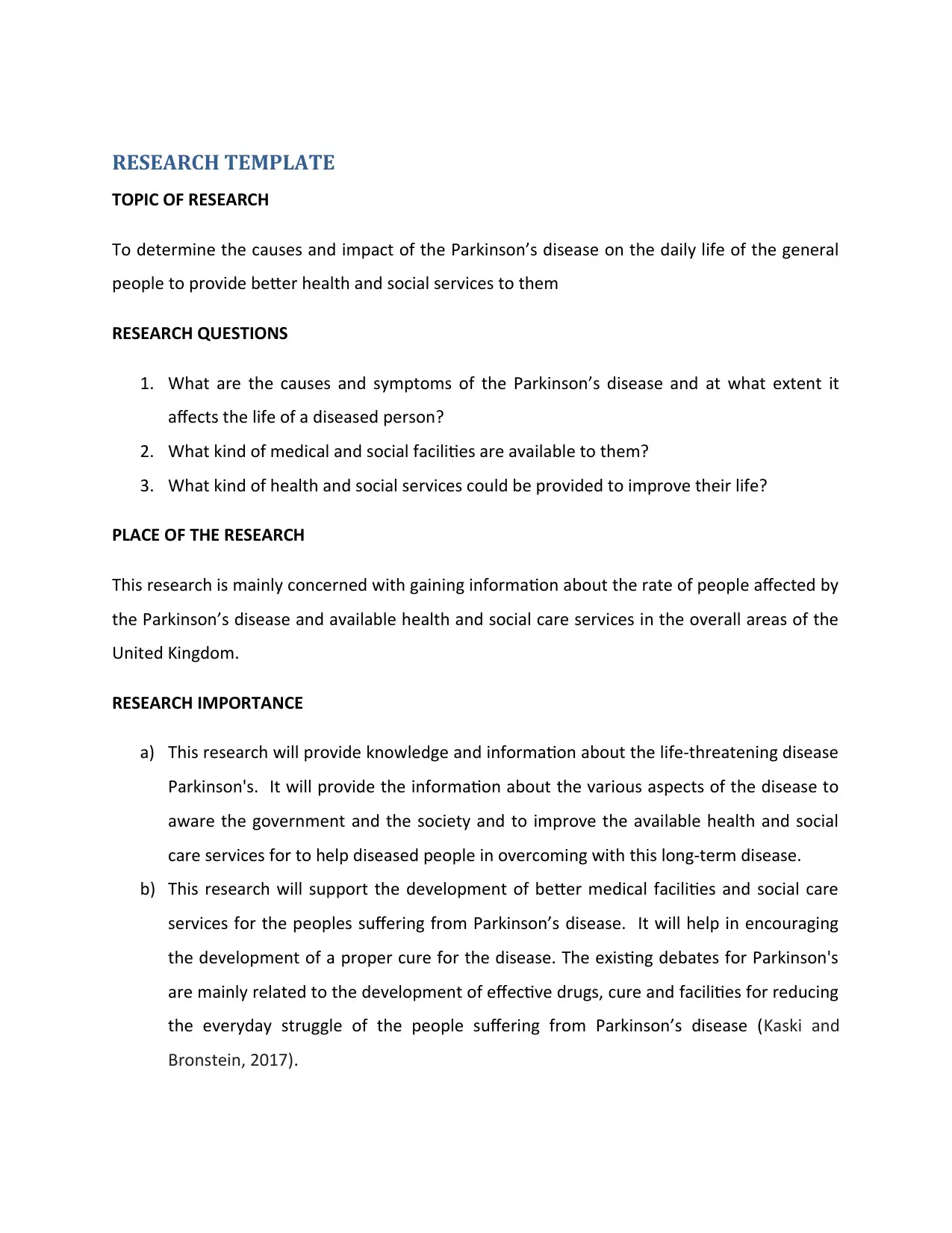
RESEARCH TEMPLATE
TOPIC OF RESEARCH
To determine the causes and impact of the Parkinson’s disease on the daily life of the general
people to provide better health and social services to them
RESEARCH QUESTIONS
1. What are the causes and symptoms of the Parkinson’s disease and at what extent it
affects the life of a diseased person?
2. What kind of medical and social facilities are available to them?
3. What kind of health and social services could be provided to improve their life?
PLACE OF THE RESEARCH
This research is mainly concerned with gaining information about the rate of people affected by
the Parkinson’s disease and available health and social care services in the overall areas of the
United Kingdom.
RESEARCH IMPORTANCE
a) This research will provide knowledge and information about the life-threatening disease
Parkinson's. It will provide the information about the various aspects of the disease to
aware the government and the society and to improve the available health and social
care services for to help diseased people in overcoming with this long-term disease.
b) This research will support the development of better medical facilities and social care
services for the peoples suffering from Parkinson’s disease. It will help in encouraging
the development of a proper cure for the disease. The existing debates for Parkinson's
are mainly related to the development of effective drugs, cure and facilities for reducing
the everyday struggle of the people suffering from Parkinson’s disease (Kaski and
Bronstein, 2017).
TOPIC OF RESEARCH
To determine the causes and impact of the Parkinson’s disease on the daily life of the general
people to provide better health and social services to them
RESEARCH QUESTIONS
1. What are the causes and symptoms of the Parkinson’s disease and at what extent it
affects the life of a diseased person?
2. What kind of medical and social facilities are available to them?
3. What kind of health and social services could be provided to improve their life?
PLACE OF THE RESEARCH
This research is mainly concerned with gaining information about the rate of people affected by
the Parkinson’s disease and available health and social care services in the overall areas of the
United Kingdom.
RESEARCH IMPORTANCE
a) This research will provide knowledge and information about the life-threatening disease
Parkinson's. It will provide the information about the various aspects of the disease to
aware the government and the society and to improve the available health and social
care services for to help diseased people in overcoming with this long-term disease.
b) This research will support the development of better medical facilities and social care
services for the peoples suffering from Parkinson’s disease. It will help in encouraging
the development of a proper cure for the disease. The existing debates for Parkinson's
are mainly related to the development of effective drugs, cure and facilities for reducing
the everyday struggle of the people suffering from Parkinson’s disease (Kaski and
Bronstein, 2017).
Paraphrase This Document
Need a fresh take? Get an instant paraphrase of this document with our AI Paraphraser
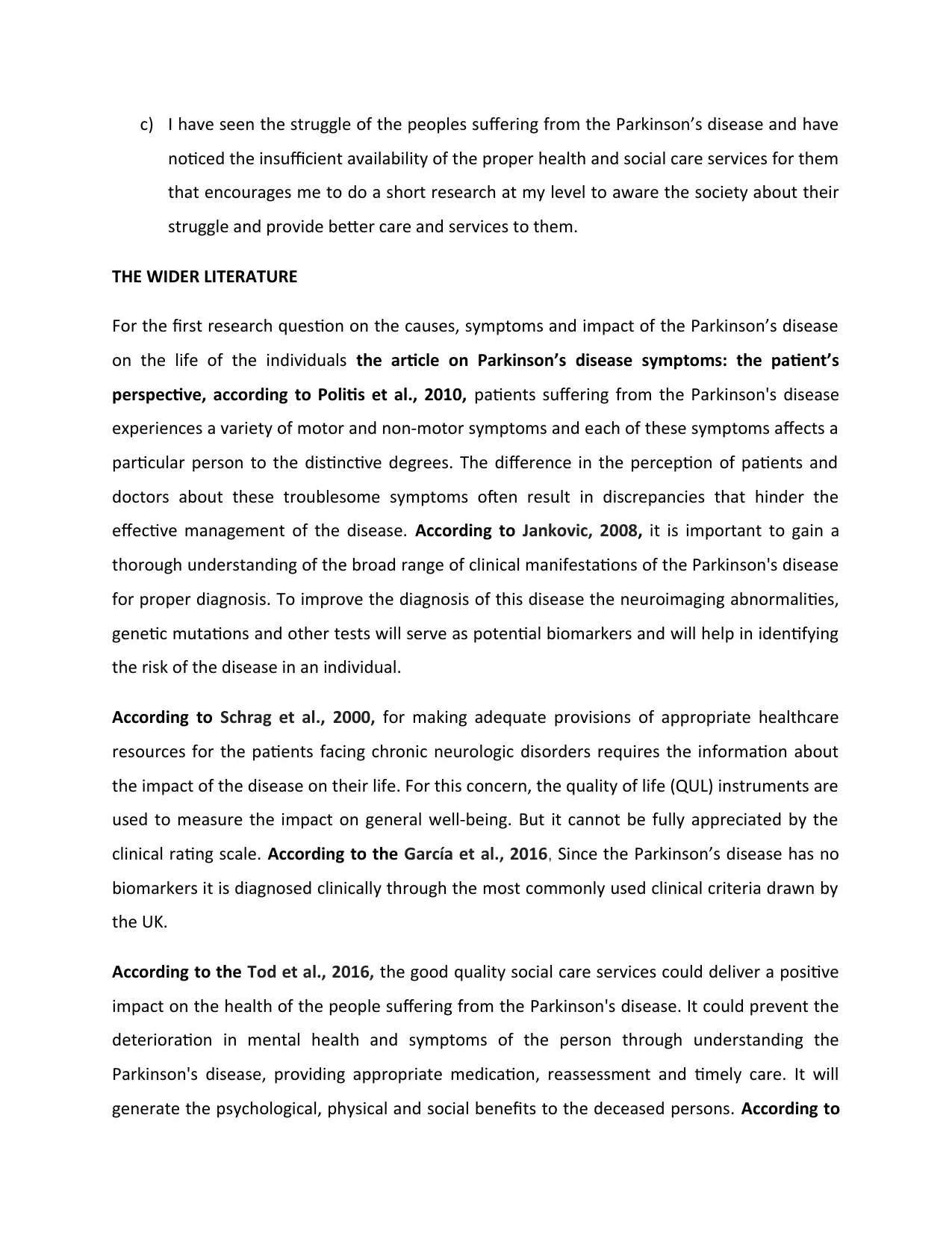
c) I have seen the struggle of the peoples suffering from the Parkinson’s disease and have
noticed the insufficient availability of the proper health and social care services for them
that encourages me to do a short research at my level to aware the society about their
struggle and provide better care and services to them.
THE WIDER LITERATURE
For the first research question on the causes, symptoms and impact of the Parkinson’s disease
on the life of the individuals the article on Parkinson’s disease symptoms: the patient’s
perspective, according to Politis et al., 2010, patients suffering from the Parkinson's disease
experiences a variety of motor and non-motor symptoms and each of these symptoms affects a
particular person to the distinctive degrees. The difference in the perception of patients and
doctors about these troublesome symptoms often result in discrepancies that hinder the
effective management of the disease. According to Jankovic, 2008, it is important to gain a
thorough understanding of the broad range of clinical manifestations of the Parkinson's disease
for proper diagnosis. To improve the diagnosis of this disease the neuroimaging abnormalities,
genetic mutations and other tests will serve as potential biomarkers and will help in identifying
the risk of the disease in an individual.
According to Schrag et al., 2000, for making adequate provisions of appropriate healthcare
resources for the patients facing chronic neurologic disorders requires the information about
the impact of the disease on their life. For this concern, the quality of life (QUL) instruments are
used to measure the impact on general well-being. But it cannot be fully appreciated by the
clinical rating scale. According to the García et al., 2016, Since the Parkinson’s disease has no
biomarkers it is diagnosed clinically through the most commonly used clinical criteria drawn by
the UK.
According to the Tod et al., 2016, the good quality social care services could deliver a positive
impact on the health of the people suffering from the Parkinson's disease. It could prevent the
deterioration in mental health and symptoms of the person through understanding the
Parkinson's disease, providing appropriate medication, reassessment and timely care. It will
generate the psychological, physical and social benefits to the deceased persons. According to
noticed the insufficient availability of the proper health and social care services for them
that encourages me to do a short research at my level to aware the society about their
struggle and provide better care and services to them.
THE WIDER LITERATURE
For the first research question on the causes, symptoms and impact of the Parkinson’s disease
on the life of the individuals the article on Parkinson’s disease symptoms: the patient’s
perspective, according to Politis et al., 2010, patients suffering from the Parkinson's disease
experiences a variety of motor and non-motor symptoms and each of these symptoms affects a
particular person to the distinctive degrees. The difference in the perception of patients and
doctors about these troublesome symptoms often result in discrepancies that hinder the
effective management of the disease. According to Jankovic, 2008, it is important to gain a
thorough understanding of the broad range of clinical manifestations of the Parkinson's disease
for proper diagnosis. To improve the diagnosis of this disease the neuroimaging abnormalities,
genetic mutations and other tests will serve as potential biomarkers and will help in identifying
the risk of the disease in an individual.
According to Schrag et al., 2000, for making adequate provisions of appropriate healthcare
resources for the patients facing chronic neurologic disorders requires the information about
the impact of the disease on their life. For this concern, the quality of life (QUL) instruments are
used to measure the impact on general well-being. But it cannot be fully appreciated by the
clinical rating scale. According to the García et al., 2016, Since the Parkinson’s disease has no
biomarkers it is diagnosed clinically through the most commonly used clinical criteria drawn by
the UK.
According to the Tod et al., 2016, the good quality social care services could deliver a positive
impact on the health of the people suffering from the Parkinson's disease. It could prevent the
deterioration in mental health and symptoms of the person through understanding the
Parkinson's disease, providing appropriate medication, reassessment and timely care. It will
generate the psychological, physical and social benefits to the deceased persons. According to
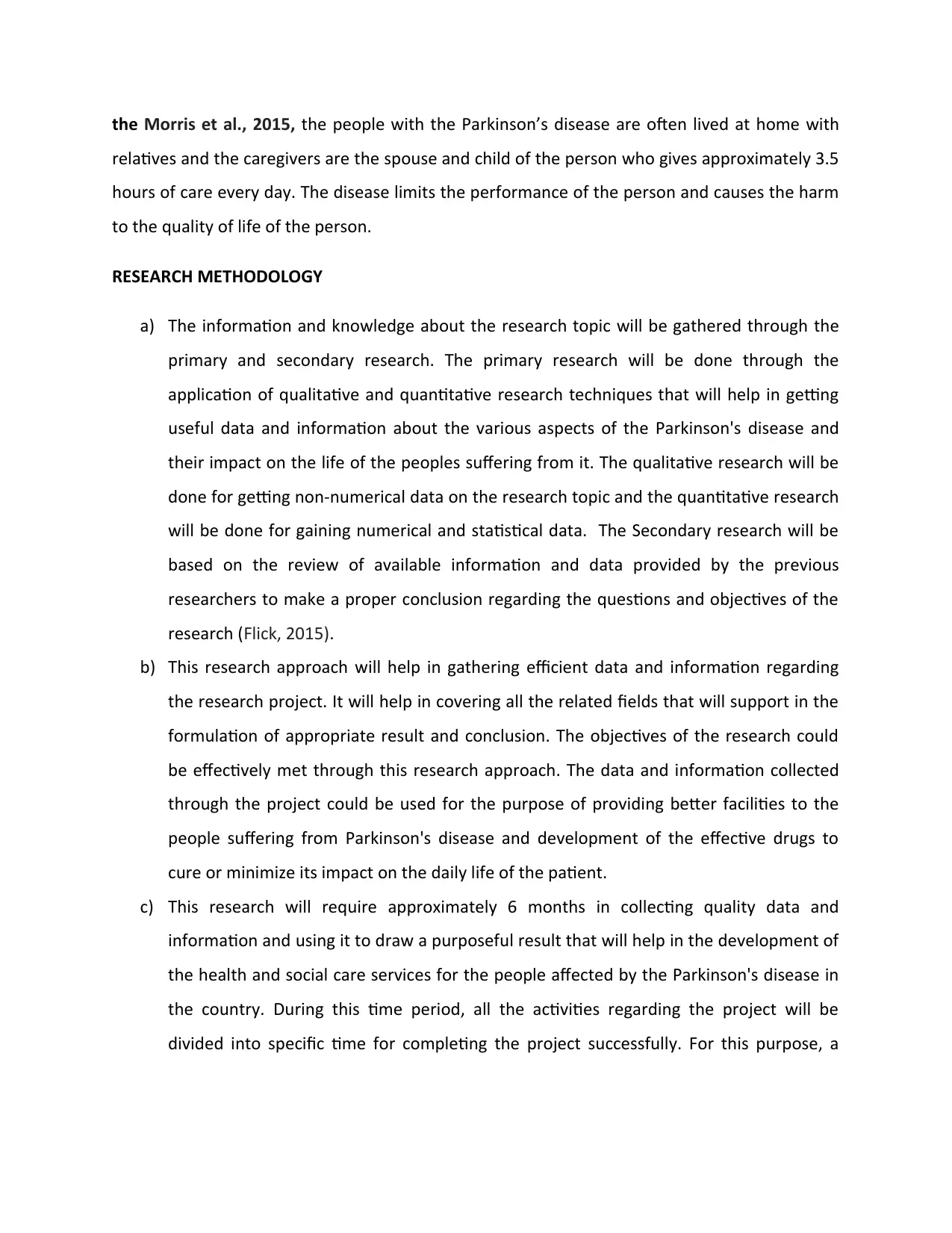
the Morris et al., 2015, the people with the Parkinson’s disease are often lived at home with
relatives and the caregivers are the spouse and child of the person who gives approximately 3.5
hours of care every day. The disease limits the performance of the person and causes the harm
to the quality of life of the person.
RESEARCH METHODOLOGY
a) The information and knowledge about the research topic will be gathered through the
primary and secondary research. The primary research will be done through the
application of qualitative and quantitative research techniques that will help in getting
useful data and information about the various aspects of the Parkinson's disease and
their impact on the life of the peoples suffering from it. The qualitative research will be
done for getting non-numerical data on the research topic and the quantitative research
will be done for gaining numerical and statistical data. The Secondary research will be
based on the review of available information and data provided by the previous
researchers to make a proper conclusion regarding the questions and objectives of the
research (Flick, 2015).
b) This research approach will help in gathering efficient data and information regarding
the research project. It will help in covering all the related fields that will support in the
formulation of appropriate result and conclusion. The objectives of the research could
be effectively met through this research approach. The data and information collected
through the project could be used for the purpose of providing better facilities to the
people suffering from Parkinson's disease and development of the effective drugs to
cure or minimize its impact on the daily life of the patient.
c) This research will require approximately 6 months in collecting quality data and
information and using it to draw a purposeful result that will help in the development of
the health and social care services for the people affected by the Parkinson's disease in
the country. During this time period, all the activities regarding the project will be
divided into specific time for completing the project successfully. For this purpose, a
relatives and the caregivers are the spouse and child of the person who gives approximately 3.5
hours of care every day. The disease limits the performance of the person and causes the harm
to the quality of life of the person.
RESEARCH METHODOLOGY
a) The information and knowledge about the research topic will be gathered through the
primary and secondary research. The primary research will be done through the
application of qualitative and quantitative research techniques that will help in getting
useful data and information about the various aspects of the Parkinson's disease and
their impact on the life of the peoples suffering from it. The qualitative research will be
done for getting non-numerical data on the research topic and the quantitative research
will be done for gaining numerical and statistical data. The Secondary research will be
based on the review of available information and data provided by the previous
researchers to make a proper conclusion regarding the questions and objectives of the
research (Flick, 2015).
b) This research approach will help in gathering efficient data and information regarding
the research project. It will help in covering all the related fields that will support in the
formulation of appropriate result and conclusion. The objectives of the research could
be effectively met through this research approach. The data and information collected
through the project could be used for the purpose of providing better facilities to the
people suffering from Parkinson's disease and development of the effective drugs to
cure or minimize its impact on the daily life of the patient.
c) This research will require approximately 6 months in collecting quality data and
information and using it to draw a purposeful result that will help in the development of
the health and social care services for the people affected by the Parkinson's disease in
the country. During this time period, all the activities regarding the project will be
divided into specific time for completing the project successfully. For this purpose, a
⊘ This is a preview!⊘
Do you want full access?
Subscribe today to unlock all pages.

Trusted by 1+ million students worldwide

Gantt chart will be used for clearly stating the required time frame for a specific activity
of the project (Flick, 2015).
of the project (Flick, 2015).
Paraphrase This Document
Need a fresh take? Get an instant paraphrase of this document with our AI Paraphraser
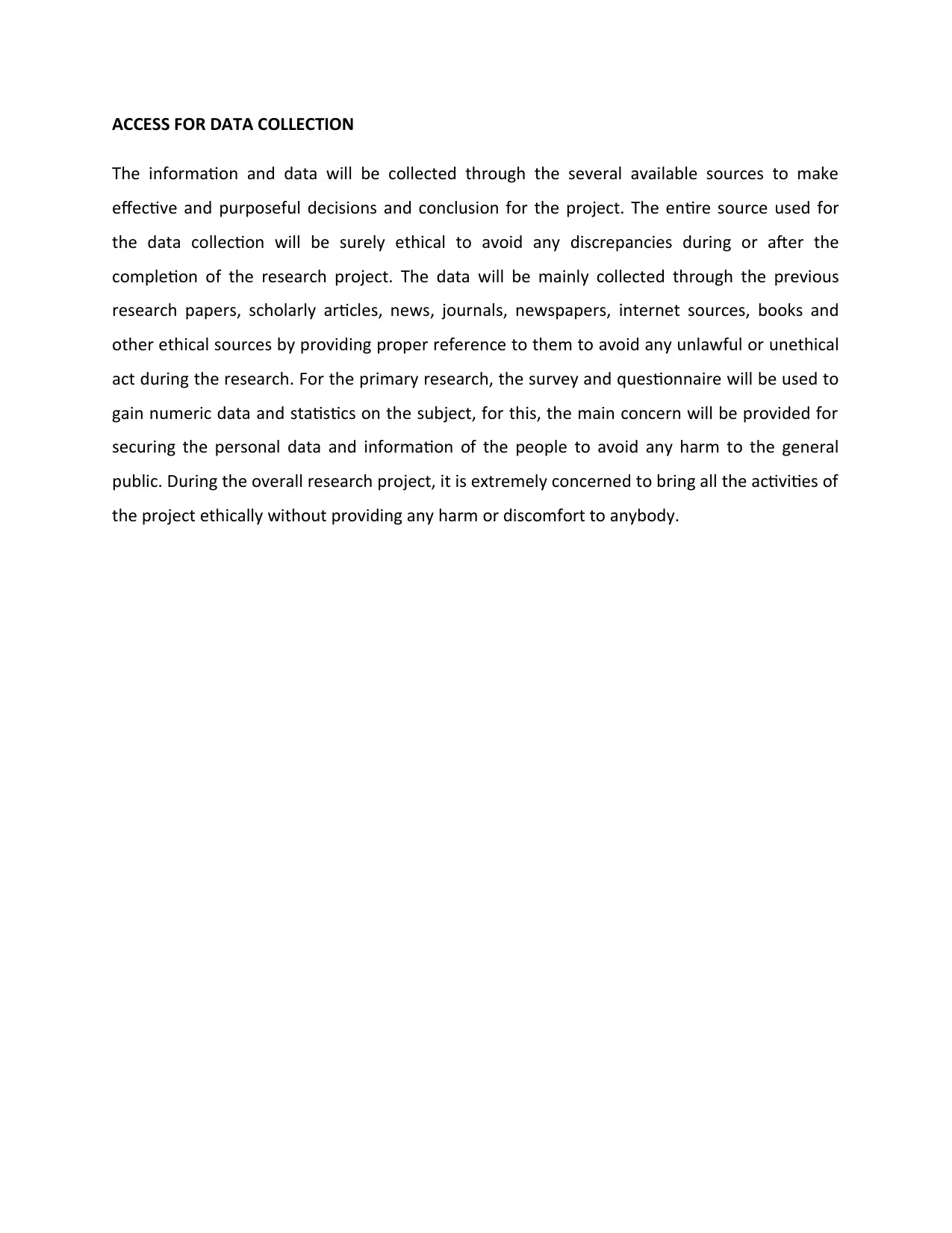
ACCESS FOR DATA COLLECTION
The information and data will be collected through the several available sources to make
effective and purposeful decisions and conclusion for the project. The entire source used for
the data collection will be surely ethical to avoid any discrepancies during or after the
completion of the research project. The data will be mainly collected through the previous
research papers, scholarly articles, news, journals, newspapers, internet sources, books and
other ethical sources by providing proper reference to them to avoid any unlawful or unethical
act during the research. For the primary research, the survey and questionnaire will be used to
gain numeric data and statistics on the subject, for this, the main concern will be provided for
securing the personal data and information of the people to avoid any harm to the general
public. During the overall research project, it is extremely concerned to bring all the activities of
the project ethically without providing any harm or discomfort to anybody.
The information and data will be collected through the several available sources to make
effective and purposeful decisions and conclusion for the project. The entire source used for
the data collection will be surely ethical to avoid any discrepancies during or after the
completion of the research project. The data will be mainly collected through the previous
research papers, scholarly articles, news, journals, newspapers, internet sources, books and
other ethical sources by providing proper reference to them to avoid any unlawful or unethical
act during the research. For the primary research, the survey and questionnaire will be used to
gain numeric data and statistics on the subject, for this, the main concern will be provided for
securing the personal data and information of the people to avoid any harm to the general
public. During the overall research project, it is extremely concerned to bring all the activities of
the project ethically without providing any harm or discomfort to anybody.
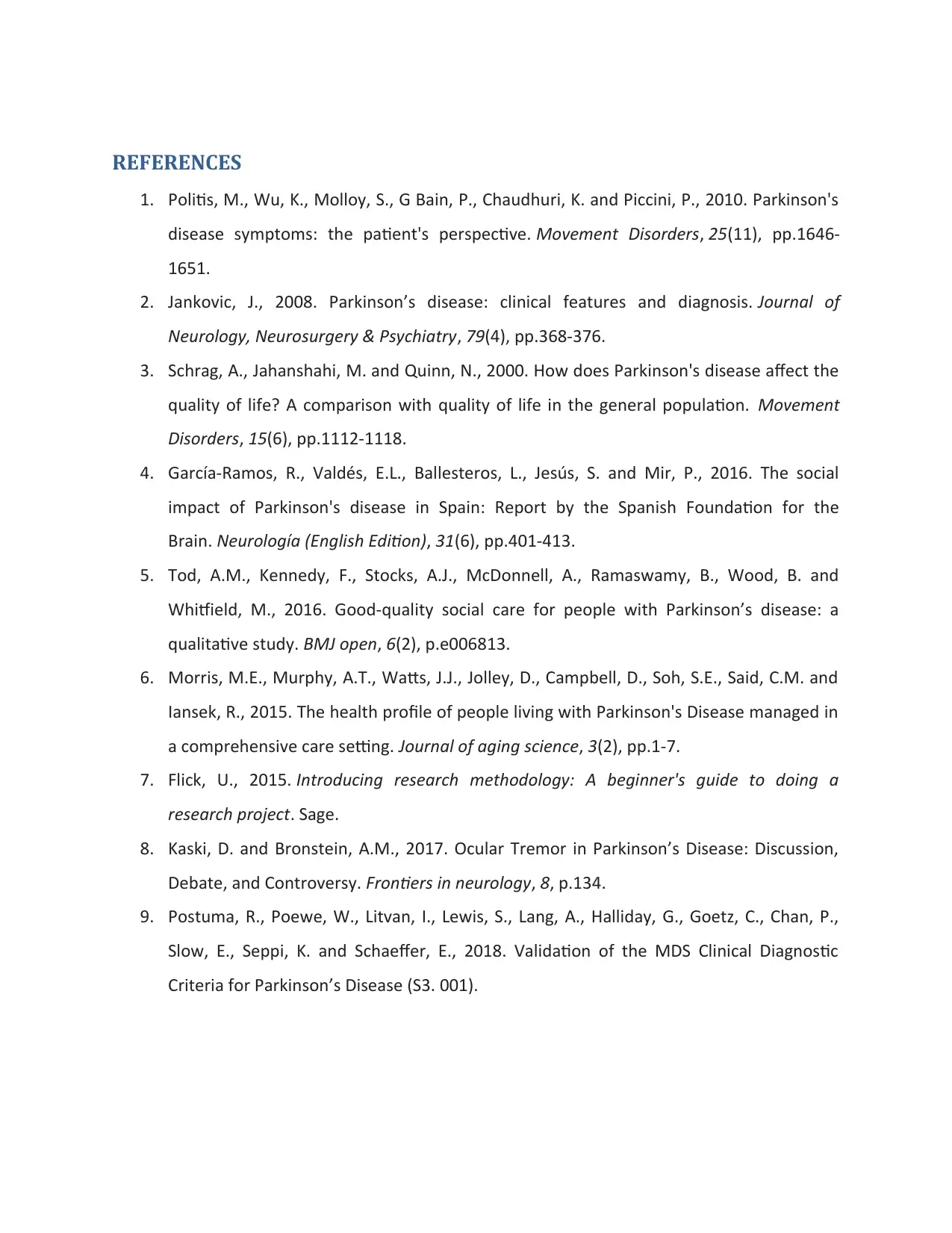
REFERENCES
1. Politis, M., Wu, K., Molloy, S., G Bain, P., Chaudhuri, K. and Piccini, P., 2010. Parkinson's
disease symptoms: the patient's perspective. Movement Disorders, 25(11), pp.1646-
1651.
2. Jankovic, J., 2008. Parkinson’s disease: clinical features and diagnosis. Journal of
Neurology, Neurosurgery & Psychiatry, 79(4), pp.368-376.
3. Schrag, A., Jahanshahi, M. and Quinn, N., 2000. How does Parkinson's disease affect the
quality of life? A comparison with quality of life in the general population. Movement
Disorders, 15(6), pp.1112-1118.
4. García-Ramos, R., Valdés, E.L., Ballesteros, L., Jesús, S. and Mir, P., 2016. The social
impact of Parkinson's disease in Spain: Report by the Spanish Foundation for the
Brain. Neurología (English Edition), 31(6), pp.401-413.
5. Tod, A.M., Kennedy, F., Stocks, A.J., McDonnell, A., Ramaswamy, B., Wood, B. and
Whitfield, M., 2016. Good-quality social care for people with Parkinson’s disease: a
qualitative study. BMJ open, 6(2), p.e006813.
6. Morris, M.E., Murphy, A.T., Watts, J.J., Jolley, D., Campbell, D., Soh, S.E., Said, C.M. and
Iansek, R., 2015. The health profile of people living with Parkinson's Disease managed in
a comprehensive care setting. Journal of aging science, 3(2), pp.1-7.
7. Flick, U., 2015. Introducing research methodology: A beginner's guide to doing a
research project. Sage.
8. Kaski, D. and Bronstein, A.M., 2017. Ocular Tremor in Parkinson’s Disease: Discussion,
Debate, and Controversy. Frontiers in neurology, 8, p.134.
9. Postuma, R., Poewe, W., Litvan, I., Lewis, S., Lang, A., Halliday, G., Goetz, C., Chan, P.,
Slow, E., Seppi, K. and Schaeffer, E., 2018. Validation of the MDS Clinical Diagnostic
Criteria for Parkinson’s Disease (S3. 001).
1. Politis, M., Wu, K., Molloy, S., G Bain, P., Chaudhuri, K. and Piccini, P., 2010. Parkinson's
disease symptoms: the patient's perspective. Movement Disorders, 25(11), pp.1646-
1651.
2. Jankovic, J., 2008. Parkinson’s disease: clinical features and diagnosis. Journal of
Neurology, Neurosurgery & Psychiatry, 79(4), pp.368-376.
3. Schrag, A., Jahanshahi, M. and Quinn, N., 2000. How does Parkinson's disease affect the
quality of life? A comparison with quality of life in the general population. Movement
Disorders, 15(6), pp.1112-1118.
4. García-Ramos, R., Valdés, E.L., Ballesteros, L., Jesús, S. and Mir, P., 2016. The social
impact of Parkinson's disease in Spain: Report by the Spanish Foundation for the
Brain. Neurología (English Edition), 31(6), pp.401-413.
5. Tod, A.M., Kennedy, F., Stocks, A.J., McDonnell, A., Ramaswamy, B., Wood, B. and
Whitfield, M., 2016. Good-quality social care for people with Parkinson’s disease: a
qualitative study. BMJ open, 6(2), p.e006813.
6. Morris, M.E., Murphy, A.T., Watts, J.J., Jolley, D., Campbell, D., Soh, S.E., Said, C.M. and
Iansek, R., 2015. The health profile of people living with Parkinson's Disease managed in
a comprehensive care setting. Journal of aging science, 3(2), pp.1-7.
7. Flick, U., 2015. Introducing research methodology: A beginner's guide to doing a
research project. Sage.
8. Kaski, D. and Bronstein, A.M., 2017. Ocular Tremor in Parkinson’s Disease: Discussion,
Debate, and Controversy. Frontiers in neurology, 8, p.134.
9. Postuma, R., Poewe, W., Litvan, I., Lewis, S., Lang, A., Halliday, G., Goetz, C., Chan, P.,
Slow, E., Seppi, K. and Schaeffer, E., 2018. Validation of the MDS Clinical Diagnostic
Criteria for Parkinson’s Disease (S3. 001).
⊘ This is a preview!⊘
Do you want full access?
Subscribe today to unlock all pages.

Trusted by 1+ million students worldwide
1 out of 6
Related Documents
Your All-in-One AI-Powered Toolkit for Academic Success.
+13062052269
info@desklib.com
Available 24*7 on WhatsApp / Email
![[object Object]](/_next/static/media/star-bottom.7253800d.svg)
Unlock your academic potential
Copyright © 2020–2025 A2Z Services. All Rights Reserved. Developed and managed by ZUCOL.





